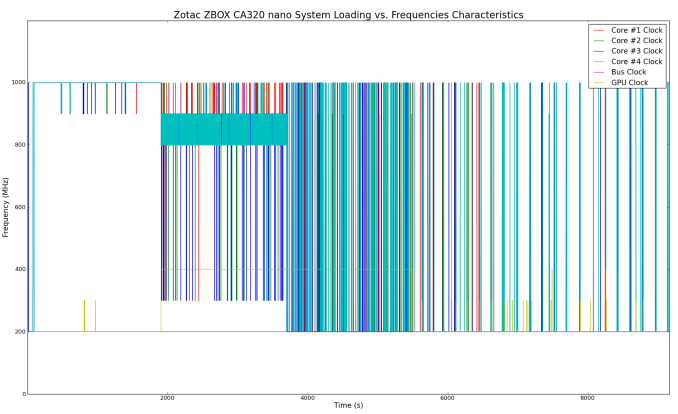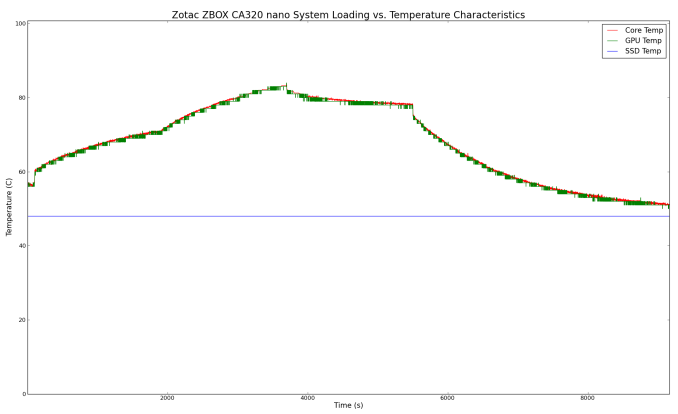Zotac ZBOX CA320 nano PLUS Review: A Fanless AMD mini-PC
by Ganesh T S on November 26, 2014 2:00 PM ESTPower Consumption and Thermal Performance
The power consumption at the wall was measured with a 1080p display being driven through the HDMI port. In the graphs below, we compare the idle and load power of the Zotac ZBOX CA320 nano with other low power PCs evaluated before. For load power consumption, we ran Furmark 1.12.0 and Prime95 v27.9 together. The numbers are not beyond the realm of reason for the combination of hardware components in the machine.


We do find that the idle power consumption is lower than the ZBOX CI540 nano, but it doesn't match the numbers set by the ECS LIVA. As expected, the load power consumption tracks the inherent capabilities of the CPU in the system.
We evaluated the thermal performance from a system perspective. We start with the system at idle, followed by 30 minutes of pure CPU loading. This is followed by another 30 minutes of both CPU and GPU being loaded simultaneously. After this, the CPU load was removed, allowing the GPU to be loaded alone for another 30 minutes. The various clocks in the system as well as the temperatures within the unit are presented below.
At the outset, it must be said that we didn't observe any throttling in action. The CPU cores are advertised for 1 GHz and they maintain that frequency throughout the pure CPU loading stage. The GPU cores idle around 200 MHz. After the GPU load kicks in, the Radeon HD 8250 cranks up to 400 MHz, while the CPU cores move down to the 800 - 900 MHz (and occasionally up to 1 GHz) range to obey the TDP limits. After removal of the CPU load, the cores dial down to 200 MHz (just cranking up once in a while). On the temperature side of things, the core and GPU track each other closely. The junction temperature is around 90 C, and the maximum temperature we encountered in our stress test was slightly above 80 C. Idling temperature was around 50 C.
Another important aspect to keep note of while evaluating fanless PCs is the chassis temperature. Using Seek Thermal's thermal imager, we observed the chassis temperature after the CPU package temperature reached the steady state value in the above graph.
Surprisingly, the chassis temperature reached only 56 C after full loading. Compared to the 75 C+ that we saw with the ZBOX CI540 nano, this is really cool. Some of the other thermal pictures we took of the unit after the full loading process are reproduced in the gallery below.

















31 Comments
View All Comments
DryAir - Thursday, November 27, 2014 - link
I would also like to see a review for the Alpha.Seems to be much better than the other "gaming" mini pcs reviewed here (Brix), and its also the best deal of any PC at its price, be it OEM or DIY.
OtisRush - Wednesday, November 26, 2014 - link
Good Review. Looking forward to seeing how this one stacks up to the CI320 with the Celeron N2930 4core CPUmilli - Wednesday, November 26, 2014 - link
x264 Benchmark: 'However, it is no match for the quad-core Celeron J1900 at much higher clocks (but, one which also has a much higher TDP and is actively cooled).'The TDP difference is 8W vs 10W. Your own load testing shows 1.2W difference. How does that translate in your book into a 'much higher TDP'? The J1900 is close to double the speed.
There are enough J1900 products that are passively cooled too.
ganeshts - Wednesday, November 26, 2014 - link
There are a couple fo reasons:1. The J1900 was part of the GIGABYTE BXBT-1900 system - an actively cooled mini-PC, which could sustain the J1900 at higher clocks - the default BIOS took some liberty in allowing the SoC to be overclocked.
2. Even though the load power difference was only 1.2W, the power adapters were different - the CA320 uses a power brick with, in my educated guess, a lower efficiency compared to the plug-in wall wart used by the BXBT-1900.
I would say that the TDP difference is of the order of 4W in operation for the two PCs, and when you have 4W around the 8 - 15W ballpart, that is almost 20 - 25%. But, I do agree, I should have just used 'higher TDP' instead of 'much higher TDP'.
Conficio - Wednesday, November 26, 2014 - link
Zotac's offering with the ZBOX CI540 nano aims to strike a balance. $175 for a barebones configuration is quite reasonable for this type of system.Was it not the CA 320 under review? Typo?
ganeshts - Wednesday, November 26, 2014 - link
Thanks for spotting this! Fixed the typo.Ancalagon44 - Thursday, November 27, 2014 - link
So Zotac releases a product using Kabini 6 months after Beema/Mullins is released?Notice also that this is a mobile part, not a desktop part. So, considering they are using mobile parts, they could have used Beema or Mullins here.
But I don't blame Zotac. It is nearly impossible to buy Beema or Mullins in a notebook anyway. I blame AMD for soft-launching products MONTHS before they are actually ready to go go market.
daisysdaddy - Friday, November 28, 2014 - link
You all sound VERY TECHY... I am NOT.... HELP... Is this an independent functional computer that will hook up to a Monitor, keyboard and mouse? [I was told they are NOT a computer on their own... but only an ADD ON for a computer.??] Is it true they will not play a Movie recorded in 1080? These look interesting, and my computer SUCKS and always needs repair! These are also well priced... [higher in Canada.... but still good] Could someone reply ASAP? Thanksjospoortvliet - Saturday, November 29, 2014 - link
It is an independent computer for sure, hook up keyboard/mouse/monitor and you are good to go. It can play your videos just fine unless they are extremely high quality, the HTPC test checks if it provides also support for various post processing and 4K, which it does not - too slow for that.Throwaway007 - Wednesday, December 31, 2014 - link
This reviewer is way more intelligent than the other idiot, the one who insists on his stupid temperature delta and power consumption delta charts.Thank you, thank you, thank you!